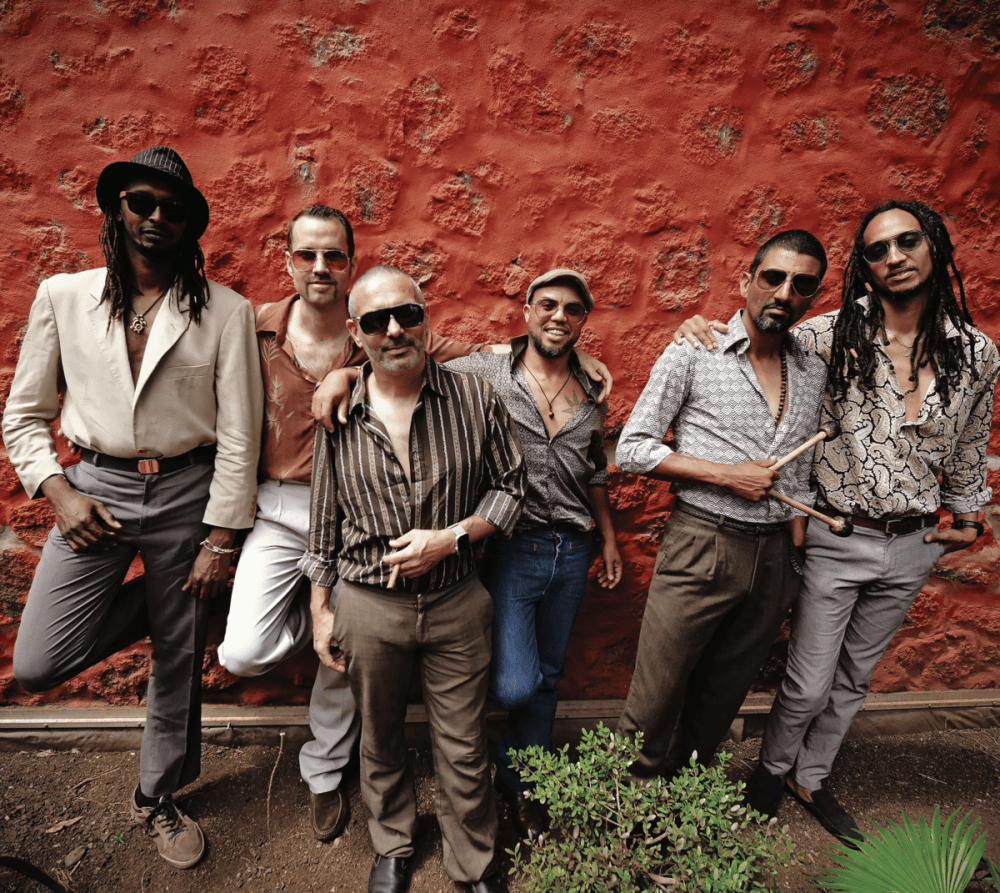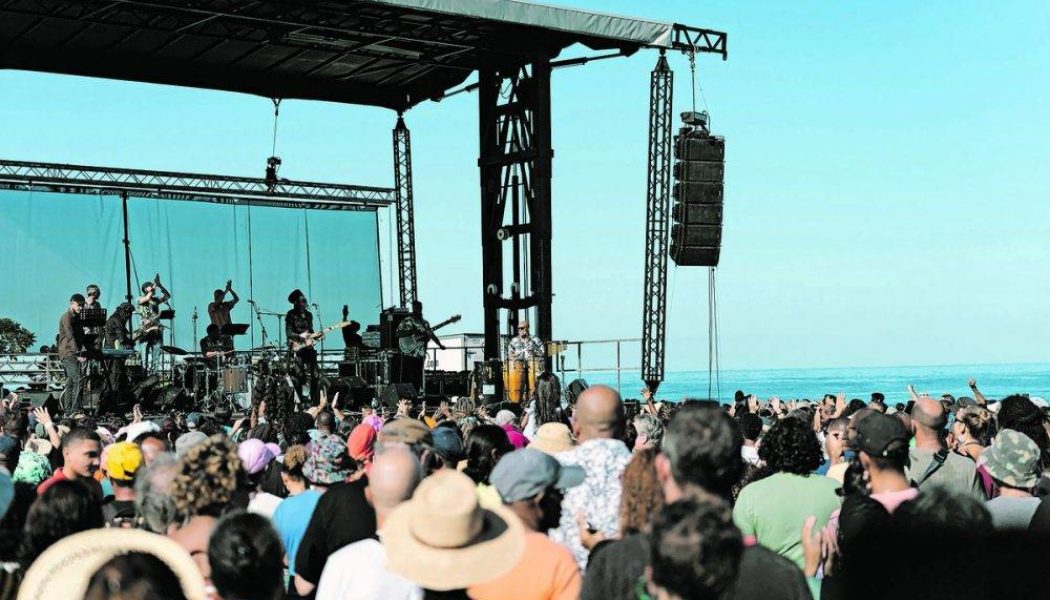
The sun is about to rise as I get my first bleary-eyed glimpse of La Réunion through the Airbus porthole and I read this as a sign of good things to come.
This will be my third visit to La Réunion. So far, this little island that punches way above its weight has not disappointed, especially musically.
I have this idea that, like reggae is Jamaica’s biggest export, maloya could easily be Réunion’s. There are reportedly more than 300 regularly performing bands, many of them household names, on the island, which has a population of just under one million people.
There’s even a record press, a remnant, I dare say, of happier days.
I first heard Danyèl Waro’s name about three years ago. At the same time, I heard about maloya, the rebel music of the island. Now I can interview the vaunted yab (more about that later) from the Réunion montaignes — and several other bands and musicians — thanks to Sakifo, the music festival on the shore of Ravine Blanche in the village of St Pierre.
Festival director and founder Jérôme Galabert’s philosophy of “you can only do great things if you enjoy what you’re doing” has a ring of truth. He is everywhere, listening intently to the bands he has booked, chatting to punters, wandering around in a colourful shirt with a big smile. No wonder it’s Sakifo’s 20th edition!
The festival has a cool, laid-back vibe and it’s a rare event where the two factions on the island, the Réunionnais and the Français, meet and have a good time together.
“Sakifo” means “what’s needed” in Creole and that is indeed what the island needs — apart from a good jive to an excellent line-up.
This year’s line-up is almost as hot as the lava occasionally spewing forth from the Piton de la Fournaise, the live volcano on the island’s south-eastern side, and features top acts from around the world.
Stogie T and The Joy from South Africa will be there, and receive the crowd’s enthusiastic blessing but, to be honest, my interest lies with maloya, the rousing music unique to Réunion, and séga, its more melodic cousin, found on all the islands of the Mascarenes, including Mauritius and Rodriquez.

To understand maloya you must understand where it comes from, because the music and politics of the island are as intertwined as the plaited strands of a koeksister.
Maloya is a powerful blend of music from Madagascar, Mozambique and the south-eastern Malabar coast of India, where most of the slaves came from around the late 1600s. Robbed of everything they knew, except their lives, which were forcefully dedicated to intensive labour, maloya was a spiritual outlet as well as a source of sustenance for enslaved people.
It served as a trance-inducing accompaniment to the black, ancestor-worshipping religions of these early inhabitants, the so-called servis kabare, but was also a way of secretly (and subversively) remembering who you were and where you came from.
The Catholic Church was vehemently opposed to the kabare, seeing it as devil-worship. Maloya, suppressed whenever possible, was pushed underground.
The island, then known as Ile de Bourbon, was unpopulated when the first French landed. And so, maloya became the musical sum of the cultures that settled there, its beat underpinned by the driving bass beats of the large roulér drums, often made from rum barrels, while the shikka-shikka sound of the kayamb shaker provided its hip-shaking signature.
The music is unashamedly the sound of Africa, and a reminder of the French (and European) involvement in slavery. Perhaps this is why Michel Debré, the French minister in charge of overseas territories from the 1960s to the 1980s, chose to ban Maloya and all performances of it. In fact, merely being in possession of those two instruments could get you into trouble.
Séga — the other genre that emerged on the island — was more acceptable to the colonial masters. Emerging from the same regions as maloya, but combined with European influences such as the polka and the quadrille, séga is more melodic and features European instruments such as the accordion and guitar.
Maloya is more strident and militant, unadorned as it is with softening European influences — it’s black, it’s percussive and, often, it’s angry — and it has every reason to be.
Debré’s prohibition almost killed maloya but for the intervention of the Communist Party of Réunion. Individuals such as former cane-cutter Firmin Viry, musician Waro’s mentor, saw in maloya the spirit of freedom that could unite the Réunionnais behind their battle for autonomy. “Maloya is the cry of the people,” Viry said.
In the end, autonomy didn’t happen but, in 1982, then French minister of culture Jack Lang successfully petitioned left-wing president François Mitterrand to lift the prohibition on maloya. Released from its decades-long bondage, it literally exploded onto the scene.
The music itself has not remained static, though maloya sek — dry (traditional) maloya — remains the preferred genre of activists.
Alain Peters, Maya Kamaty, Ziskakan, Baster and others have added electric, and even electronic, instrumentation to the line-up, and mixed zouk, samba, afrobeat, rock, reggae and Tamil folk music with maloya. But there is little doubt that, if a revolution were to occur today, it would be announced through maloya.
“We are brothers,” says Michel, from the band Pat’ Jaune, pointing at his skin and his face and then mine. It feels so. We’ve been having a convivial chat, despite me having no French and him virtually no English.
Michel and his band members, Bernard, Lynda, Francois and Loïc are yabs, from La Plaine des Cafres, the literal translation of which is exactly what you think it is, so it needs some context. Creole is anyone born on the island and the zoreille are mainland French.
I can’t find a proper translation for this word but a not-so-kind legend has it that it means “the ears” originating from a World War II government warning: Méfiez-vous! Les oreilles ennemies vous écoutent! (Be careful! Enemy ears are listening!)
Whites are also known as petit blancs (small whites) and the landowning elites are known as gros blancs (big whites).
Yabs are petit blancs, later given land by the French state, on which they farmed. Because the prime coastal strip already belonged to the gros blancs, this land was high in the mountains.
The word derives from the Malagasy word “yabu” meaning “in the mountains”; zarabe are Muslims of Indian descent and malbar Indians from Tamil — both groups arrived as indentured labour.
Malgache are people from Madagascar; chinoise, Chinese and Vietnamese, and kaf, an unmentionable term here in South Africa, is used by the islanders, including the kaf themselves, to describe people of African descent — and proudly so.
Interestingly, there appears to be little or no tension between the various ethnicities who identify as Creole. What tension exists on this paradisical island is between the Creole and the Zoreille, as many maloya songs testify.

Back to Pat’ Jaune — the band members are two sets of siblings, from the Gonthier and Tarby families, and the music they play is described on the Sakifo brochure as “Réunion Fusion”, but my ear says it sounds a lot like vastrap and boere-musiek. And, as I discover, there are many more similarities.
Pat’ Jaune’s music is neither maloya, nor séga, but derives from both, plus the polka, quadrille and mazurka — much like boeremusiek.
“My 81-year-old mother used to listen to those songs and that’s what has inspired our music,” Michel says, “We just added maloya.”
Like most boeremusiek practitioners, Pat’ Jaune are barefoot musicians — all their music is played by ear. They cannot read or write music.
Their families have been farming turmeric on the Plaine des Cafres for generations, and that’s where their name comes from — “yellow feet”, from the turmeric. I’m beginning to feel at home with these guys.
After the interview, I play them some of boeremusiek pioneer David de Lange’s music and they sit back in amazement — they can’t believe this music, that sounds so much like theirs, exists so close by and no one there has heard of it.
I translate the word, saying boeremusiek is the music of farmers, like you and your music. I come a bit unstuck trying to translate the term vastrap. No matter, we’re on the same page.
When I watch their show later, I wish for the hundredth time that I could speak French, just a little — enough to understand what’s happening on stage.
There’s a lot of banter and a lot of laughter, from the audience as well as the band. Eventually, just before they get to playing a rousing polka, they turn their hats around and inside out, pulling them deep down on their heads and start acting like dim-witted hillbillies, mocking the prejudice they are no doubt subjected to, being yellow-footed yabs from the highlands.
Dogo Fara pops out on the festival’s webpage, simply because of the name, which is definitely not French or Creole.
I like the idea that these Réunion musicians create depth and intrigue through their band names. Kafmaron, for example, made up from “kaf” — black African, and “maron” — escaped slave. Or Baster, not bastard, as I thought, but Basse Terre, the area from which the band comes.
I have an opportunity to talk to the band before their show and I’m introduced to their singer, a tall, gangly guy who introduces himself as Masai and a much shorter man whose name I think is Laurent.
I ask him about their band’s name. Dogo Fara means “small stone” or “little rock” in the Mandinka language, which hails from West Africa, he says.
The small stone in the shoe? The one that bothers? I ask, and they laugh knowingly.
They’re a big band, a six-piece, and their line-up is a mix of African and Western instruments; bass and lead guitars, saxophone and a regular drumkit, a djembe, a collection of other African drums played with sticks, and two marimbas.
“Not marimbas,” Masai corrects me, “balofons. Marimba has a double row keyboard from Mozambique, and balofon has a single row, and comes from West Africa.”
How come your band’s name comes from West Africa and your name from East Africa? I ask. Long story, he says, laughing heartily, then wipes his face without touching it.
“It’s my look,” he says. “My friend visited Tanzania and when he returned, he told me some people there, Masai, look like me. Friends started calling me Masai. Later, we were invited to play at Sauti za Busara Festival in Zanzibar and I met a Masai, and saw for myself, it’s true.”
What are your plans for the future? I ask, expecting to hear Paris, Germany, the UK. “Kirstenbosch,” he says, surprising me. “We want to play at Kirstenbosch.”
That evening, I see them on stage. I had listened to a few of their tunes on YouTube, and I liked what I heard, but it was nothing like the performance they give that evening. The mélange of balafons, sax, djembe and guitar creates a unique, highly danceable, sound and the crowd takes to them with great enthusiasm. Kirstenbosch here they come!
Danyél Waro is a true son of the Réunion soil who can trace his lineage back several generations, way back to the first petit blanc settlers from Picardy in 1665. But this history is not the most interesting thing about Waro.
Born Daniel Houreau in 1955, it took the yab from the highlands behind St Pierre 18 years to discover maloya, but once he had, he could never let go of it. He became its champion and a living symbol of the Creole culture of Réunion.
Today, Waro is — except possibly for sugar and rum — the island’s most important export.
I was a little nervous, waiting in the designated area for my turn to talk to the island’s biggest star. Stars can be tricky. But I needn’t have worried. A humbler man would be hard to find.
Waro shakes my hand warmly, looking me in the eye. He is dressed in neutral colours, with a head of thinning red hair, a coco rouge from the mountains, one of those, legend has it, whose hair had been tinted by the lava of the nearby Piton. He wears glasses behind which a pair of lively eyes looks at the world differently. His entire being emits positive energy. And he is clearly never going to let the old man in.
In 1982, the same year in which maloya was unbanned, Daniel Houreau became Danyél Waro. Perhaps it’s his song Adekalom, which he wrote at the time as an ode to two desperate brothers criminalised by the French government in far-away Paris — 11 000km to be precise — which inspired an additional act of simpatico; or perhaps it was just the recognition that you had to exert yourself to become you.
There was no going back to Daniel Houreau. Thereafter, he would only answer to the name Danyél Waro and sing and speak only in Creole. These acts made him the darling of the islanders but did not necessarily endear him to the French.
Earlier, on my way to the interview, I make small talk with the driver. He’s been here seven years, he says. As we drive past a cemetery, he tells me of a Robin Hood-like hero buried there who stole from the rich (French) and gave to the poor (Creole).
When you visit the grave, you must leave him some rum, he jokes, before asking what I’m doing today. Interviewing Danyél Waro, I say.
“Ah!” he says, raising his eyebrows and wrinkling up his nose as if there was a sudden unpleasant whiff in the car. “Waro … hmmm. He only speaks Creole … careful!”
What an odd thing to say, I thought. What on earth should I be careful of? Later that afternoon someone else responded similarly, criticising Waro’s preference for Creole, and I realised there was more to this than mere prejudice.
Waro threatened the status quo, like our own Johnny Clegg did. Clegg was a hero to some, but certainly not all, South Africans. There are a lot of similarities between Waro, a white man who played maloya and embraced Creole culture and Clegg, a white man who crossed maskanda with folk and embraced Zulu culture.
They both broke the rules, subverted convention, but Waro took it several steps further. I ask him whether he knew Clegg. The translator does not have to translate, Waro starts answering immediately, a smile on his face.
Yes, he knew Johnny. They shared stages three times, the first time at Sakifo. “I opened for him in 2004,” he says. “The first Sakifo festival. A powerful show.”
I’d like to chat more about the Clegg-Waro connection but the 20 minutes of the interview have just about run out and the translator is eyeing her phone.
Later that evening, I catch his show at the other end of the festival terrain. By the time I get there, 10 minutes before it starts, the place is packed. This is significant, because Waro is by no means a dance act.
His music is political, spiritual and deeply personal. You aren’t going to hop about mindlessly at a Waro show, even I with my non-existent French know that. You might rhythmically sway and lilt but, essentially, you are going to listen.
From the moment he steps onto the stage, he holds the crowd hostage. They hang onto his every word.

When he starts singing Mandela, his homage to Madiba, his voice thins and cracks with emotion, and I don’t have to understand French to know he deeply respected the man.
“What is wisdom, Mandela, teach me; what is dignity, Mandela, teach me,” he pleads.
He finishes the song to massive applause. These people love him, that’s clear. A red-haired saint from the mountains, he touches the Réunionnais with every word.
In between the jumble of Creole call-and-response with the audience, I hear a word he used earlier, during the interview: “batarcité”. I had read about it elsewhere and it intrigued me. What does he mean by it? No luck trying to find it in a dictionary — it’s a Waro-word.
“Ah, batarcité, oui,” he says with a gentle smile, glancing up at the clear blue Reunion sky. “Batarcité is a question about who I am, where I am. I am high yab, I am kaf, I am malbar, I am chinoise, I am zarabe.”
He looks at me intently, points at his chest with both hands “I am a bastard. Maloya is a mongrel. We have to look at ourselves in the mirror and we should be proud. This is the work we have to do. I don’t want to choose. I am my own sauce. That is my batarcité.”
Honestly, I want it to be mine, too.
Carsten Rasch is the author of 1980s music memoir Between Rock & a Hard Place. He is working on The Beat Routes — African music’s journey around the world.









